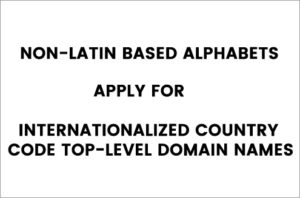
Date: 01/01/2009Since 2009, countries with non–Latin-based scripts may apply for internationalized country code top-level domain names, which are displayed in end-user applications in their language-native script or alphabet, but use a Punycode-translated ASCII domain name in the Domain Name System.
IDN ccTLDs are specially encoded domain names that are displayed in an end user application, such as a web browser, in their language-native script or alphabet, such as the Arabic alphabet, or a non-alphabetic writing system, such as Chinese characters. IDN ccTLDs are an application of the internationalized domain name system to top-level Internet domains assigned to countries, or independent geographic regions.
Although the domain class uses the term code, some of these ccTLDs are not codes but full words. For example, السعودية (as-Suʻūdiyya) is not an abbreviation of “Saudi Arabia”, but the common short-form name of the country in Arabic.
Countries with internationalized ccTLDs also retain their traditional ASCII-based ccTLDs.
As of December 2014 there are 45 approved internationalized country code top-level domains. The most used are .рф (Russia) with over 900,000 domains names, .台灣 (Taiwan) with around 500,000 and .中国 (China) with over 200,000 domains.
On May 5, 2010, the first implementations, all in the Arabic alphabet, were activated. Egypt was assigned the مصر. country code, Saudi Arabia السعودية., and the United Arab Emirates امارات., (all reading right to left as is customary in Arabic). ICANN CEO Rod Beckstrom described the launch as “historic” and “a seismic shift that will forever change the online landscape.” “This is the beginning of a transition that will make the Internet more accessible and user friendly to millions around the globe, regardless of where they live or what language they speak,” he added. Senior director for internationalised domain names Tina Dam said it was “the most significant day” since the launch of the Internet. According to ICANN, Arabic was chosen for the initial roll out because it is one of the most widely used non-Latin languages on the Internet. There are problems entering a mixed left-to-right and right-to-left text string on a keyboard, making fully Arabic web addresses extra useful.
As of June 2010, four such TLDs have been implemented: three using the Arabic alphabet, السعودية., مصر. and امارات. (for Egypt, Saudi Arabia and the United Arab Emirates, respectively), and one using Cyrillic, .рф (for Russia). Five new IDN ccTLDs using Chinese characters were approved in June 2010: .中国 with variant .中國 (for mainland China), .香港 (for Hong Kong), and .台灣 with variant .台湾 (for Taiwan).